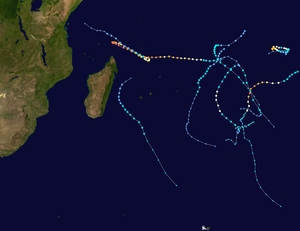2015–16 South-West Indian Ocean cyclone season
| 2015–16 South-West Indian Ocean cyclone season | |
|---|---|

Season summary map
|
|
| Seasonal boundaries | |
| First system formed | November 19, 2015 |
| Last system dissipated | April 23, 2016 |
| Strongest storm | |
| Name | Fantala |
| • Maximum winds | 250 km/h (155 mph) (10-minute sustained) |
| • Lowest pressure | 910 hPa (mbar) |
| Seasonal statistics | |
| Total disturbances | 8 |
| Total depressions | 8 |
| Total storms | 8 |
| Tropical cyclones | 3 |
| Intense tropical cyclones | 3 |
| Very intense tropical cyclones | 1 |
| Total fatalities | 13 total |
| Total damage | $4.5 million (2016 USD) |
| Related articles | |
| Severe tropical storm (MFR) | |
| Tropical storm (SSHWS) | |
| Duration | November 19 – November 24 |
|---|---|
| Peak intensity | 100 km/h (65 mph) (10-min) 986 hPa (mbar) |
| Moderate tropical storm (MFR) | |
| Tropical storm (SSHWS) | |
| Duration | December 9 – December 12 |
|---|---|
| Peak intensity | 65 km/h (40 mph) (10-min) 996 hPa (mbar) |
| Severe tropical storm (MFR) | |
| Category 1 tropical cyclone (SSHWS) | |
| Duration | January 20 – January 25 |
|---|---|
| Peak intensity | 110 km/h (70 mph) (10-min) 970 hPa (mbar) |
| Moderate tropical storm (MFR) | |
| Tropical storm (SSHWS) | |
| Duration | February 8 – February 12 |
|---|---|
| Peak intensity | 75 km/h (45 mph) (10-min) 992 hPa (mbar) |
| Intense tropical cyclone (MFR) | |
| Category 4 tropical cyclone (SSHWS) | |
| Duration | February 14 (Entered basin) – February 19 |
|---|---|
| Peak intensity | 205 km/h (125 mph) (10-min) 925 hPa (mbar) |
| Intense tropical cyclone (MFR) | |
| Category 4 tropical cyclone (SSHWS) | |
| Duration | March 15 – March 21 |
|---|---|
| Peak intensity | 205 km/h (125 mph) (10-min) 940 hPa (mbar) |
| Moderate tropical storm (MFR) | |
| Tropical storm (SSHWS) | |
| Duration | March 28 – March 30 |
|---|---|
| Peak intensity | 85 km/h (50 mph) (10-min) 992 hPa (mbar) |
| Very intense tropical cyclone (MFR) | |
| Category 5 tropical cyclone (SSHWS) | |
| Duration | April 11 – April 23 |
|---|---|
| Peak intensity | 250 km/h (155 mph) (10-min) 910 hPa (mbar) |
The 2015–16 South-West Indian Ocean cyclone season was a slightly below average season of tropical cyclone formation in the Southwest Indian Ocean. The annual cyclone season began on November 15, 2015, with the first storm, Annabelle, forming four days following. The final and strongest storm, Fantala, dissipated on April 24, 2016, though the season ended on April 30, with the exception of Mauritius and the Seychelles, where it ended on May 15. The season's activity was influenced by an ongoing El Nino, and a positive Indian Ocean Dipole.
The basin consists of the portion of the Indian Ocean west of 90°E and south of the Equator. Activity was monitored by Météo-France, the Regional Specialized Meteorological Centre in the basin. The basin is unofficially monitored by the Joint Typhoon Warning Center, which uses one-minute sustained winds and the Saffir-Simpson Hurricane Wind Scale, while Météo-France uses ten-minute sustained winds and its own scale.
Most systems of the season remained weak, with only three cyclones reaching at least tropical cyclone strength. However, the season featured Very Intense Tropical Cyclone Fantala, which became the strongest cyclone on record in the basin in terms of 10-minute sustained winds at 250 km/h (155 mph).
On October 19, the Mauritius Meteorological Services (MMS) released their summer 2015–16 outlook. An average season, with around seven to nine cyclones forming, was expected. MMS also indicated that the equatorial region to the north of Mauritius, east of Agaléga and west of Diego Garcia, could be significantly conducive for cyclone formation.
The season started on November 19, with the formation of Annabelle. After a month of inactivity, Bohale formed, but was fairly weak, and only reached moderate tropical cyclone strength. Another month passed before Corentin formed on January 20. The basin became somewhat active with Daya forming, and Uriah entering the basin in February, the climatological most active month of the season. Emeraude formed in March, quickly peaking at intense tropical cyclone strength, before quickly weakening. Also, an unmonitored tropical depression entered the basin, but became extratropical soon after. Tropical Cyclone 07 formed at the end of March. The storm was operationally declared a depression, but was upgraded in post-storm analysis to a moderate tropical cyclone. In April, the season began to wind down. Very Intense Tropical Cyclone Fantala formed near the end of the month, and reached peak intensity as the strongest tropical cyclone of the basin in terms of sustained winds. Fantala dissipated on April 24, ending the season.
...
Wikipedia
















